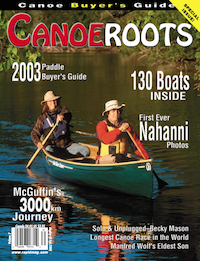With paddle in hand and journal close by, I began my 1800-kilometre lakewater canoe journey. In the high waters of late June, my partner Eric and I set off from my hometown of South River, Ontario, travelling first into Lake Nipissing. Here we followed the ancient paths of First Nations peo- ples, fur traders and settlers to the northern shore of Lake Superior.
I never imagined when I began my graduate degree in environmental studies that just months later I would be conducting research in a canoe. My aim was to experience living in a Canadian wilderness and to investigate people’s relationships to this land. What better way to do this than to travel along Canada’s largest lake by canoe?
Although the canoe may not be the fastest or the driest way to travel, it was the perfect vehicle for my research. The open canoe denotes an intimate relationship with land and water. Its manoeu- vrability and silence facilitate an encompassing sensual experience—an opportunity to listen as well as hear.
Each section of lake and shoreline that I encountered along this 60-day journey unfolded into several conversations between bodies and landscapes, water and paddles, wind, waves and canoe. All of these I recorded faithfully in a daily journal which became a narrative of my journey through the land and among the people.
Along this journey I saw that the images of forests, lakes and rivers used to represent a “Canadian Identity” are ideas steeped in a certain culture, language and history. Efforts to protect wilderness areas come from particular relationships with land and water, understandings of place that may not necessarily be shared by all Canadians.
Boundaries delineating protected wilderness areas appeared as arbitrary designations put into place with little concern for the his- tory of the land and its people. First Nations people claiming inti- mate spiritual and historical connections to the land within park borders were notably absent from parks we visited, while traditional aspects of their culture were readily used and adapted to provide entertainment for park visitors.
While claiming to protect wilderness, parks assign a cultural significance to specific lands. Park borders, however, are not immune to transgressions as flora and fauna and environmental pollutants penetrate these areas through media such as water, air and precipitation.
As I paddled over long distances through unpredictable waters, I found that the journey itself challenged accepted understandings of wilderness. Our mode of travel surprised many people who saw the canoe as perhaps out of place in modern times and their questions were always the same:What will you eat? Where will you sleep? What if it rains?
People who had paddled some of the places we were travelling told us how to experience Lake Superior, the kind of gear we need- ed, the places we should camp. While we gladly accepted this advice knowing that it came from concerned and experienced pad- dlers, I was conscious of an accepted mentality, a paddling culture promoting appropriate ways to experience the land. Speed and dis- tance seemed very important in this culture and were often discussed within an atmosphere of competition or within a conversa- tion of survival in a hostile or indifferent wilderness.
“[The Lake] defies anticipation,” remarked one woman who was paddling the North Shore of Lake Superior. She leafed through a book of her sketches of the rocky shoreline and spoke about her frustration with Superior’s unpredictable weather. Intended destinations were often not reached, schedules could not be adhered to. She sighed as she admitted to being at the mercy of the weather.
“Weather is everything,” she said. “It can make you hate or love the same place.”
The source of this woman’s frustration—an admission of nature’s power and independence from human control—echoed in many other conversations along the journey. Nowhere is the presence of a nature that is separate from human desires and control more clearly realized than in the bow of a canoe.
In a canoe on Lake Superior change was a constant. Each day of this incredible journey was completely different from the one before. Quiet, comtemplative moments became gale force winds; calm, smooth waters transformed into whitecaps and four-metre swells; slow river current ran into raging rapids and spectacular falls; complex river deltas led into the wide, unprotected expanse of open waters.
In this interactive art gallery where power and beauty are experienced by every sense, I could not have chosen a better vehicle for my research. From the unique perspective of a canoe, I was exposed to a constantly changing, unknowable nature and to many different people living within this land. I became aware of the limitations and inaccuracies of dominant definitions of wilderness. The movement of the canoe and the intense physical effort required to guide it through the natural environment afforded me an intimacy with the land that would otherwise have been unknown. I became conscious of my own culture and history as heavily influencing my ideas of wilderness. I began to question my own understanding of protection and the exclusive, controlling potential of current practices of wilderness preservation.
This journey revealed the limitations of my own and others’ attempts to represent a Canadian “wilderness.” The canoe allowed us to live the unpredictability and power of a changeable, fluid land through our bodies, our minds and our spirits.
Pauline Craig is in the Master of Environmental Studies program at York University. Her research project, entitled “Nature, Identity and the Canadian Landscape,” will continue next summer as she paddles from Lake Superior to the Mackenzie River.
 This article first appeared in the Summer 2003 issue of Canoeroots Magazine. For more great content, subscribe to Canoeroots’ print and digital editions here.
This article first appeared in the Summer 2003 issue of Canoeroots Magazine. For more great content, subscribe to Canoeroots’ print and digital editions here.



